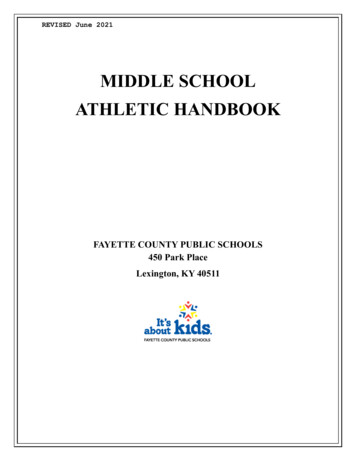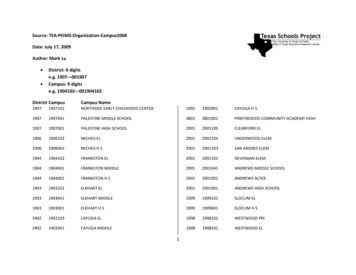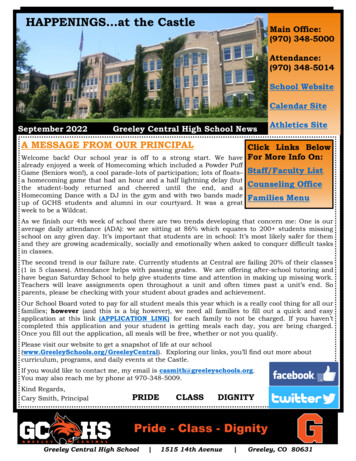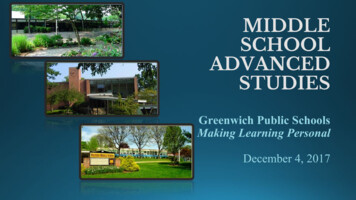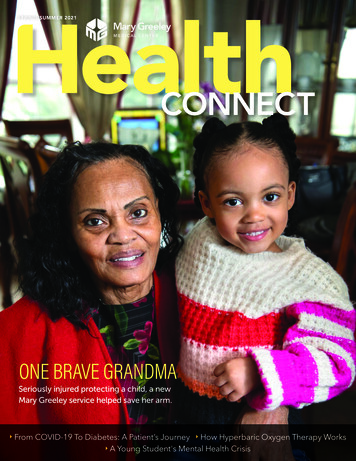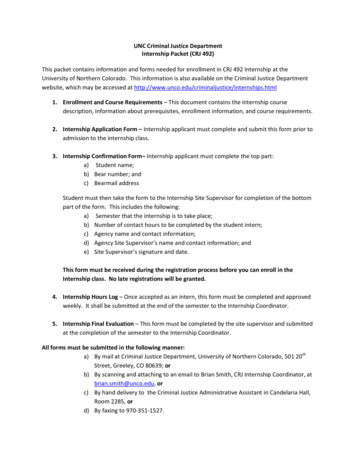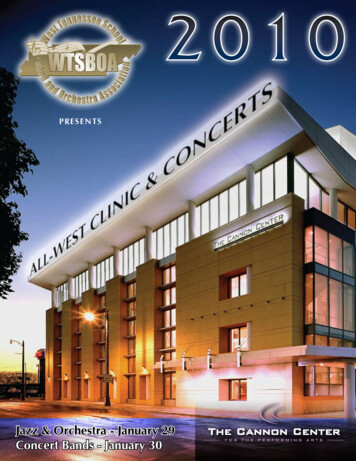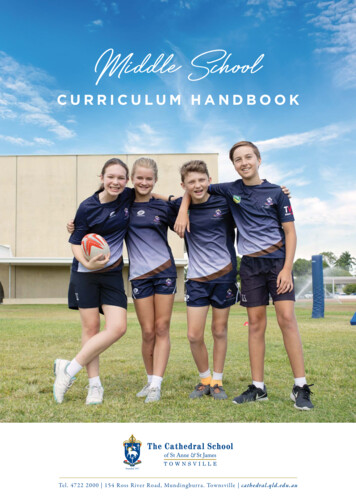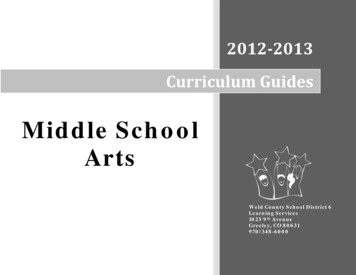
Transcription
2012-2013Curriculum GuidesMiddle SchoolArtsWeld County School District 6Learning Services1025 9th AvenueGreeley, CO 80631970/348-6000
th6 Grade
Greeley-Evans School District 6Sixth GradeUnit: DrawingEnduring Concept: The ability to use sketching and planning strategies helpsGrade Level Expectations (GLE)Standard 1. Observe and Learn to Comprehend1.1. The characteristics and expressive features of art and design are used in unique ways to respond to twoand three-dimensional art1.3. Specific art vocabulary is used to describe, analyze, and interpret works of artStandard 3. Invent and Discover to Create3.1. Plan the creation of a work of art3.2. Explore various media, materials, and techniques used to create works of artStandard 4. Relate and Connect to Transfer4.3. Eco-art is a contemporary response to environmental issues Inquiry Question(s):1. How do underlying structures unconsciously guide the creation of works of art?2. How does one critique a work of art?3. What are the advantages or disadvantages to critiquing a work of art?4. How does one start a work of art?5. What are the steps involved in finishing a work of art?6. How can a certain media give a distinctive feeling or express a particular characteristic in a work of art?7. What are some benefits or disadvantages to an artist choosing to create art in a natural environmentalsetting rather than in a traditional art setting?AssessmentsPossible Products/PerformancePossible Assessments:Tasks: Criterion Based Rubric Portraits Self-Critique Animals Peer-Critique Landscapes/ Cityscapes Artist Statement Cartooning SCR/ GIST Writing Representational Drawing Verbal Review Sketchbook PortfolioMethods of Instruction:ModelingDiscussionPlanning/ RevisionCommon Assessments: Summative Assessment Rubric Sketchbook Assessment Rubric Critique Assessment RubricDemonstrationCollaborationAnalysis/ EvaluationArt Curriculum Guideto organize within the creative processVocabulary:StipplingCross HatchMiddle GroundBlendingContourBackgroundHorizon LineVanishing PointPerspectiveValue ScaleParallelGridPerpendicularForeground*Project Specific VocabularyEvidence Outcomes1.1.a. Respond orally or in written format justifying and interpreting thecharacteristics and expressive features of art and design in a work of art1.3.a. Describe the characteristics and expressive features of art and design inselected works of art3.1.a. Use planning tools to create works of art3.2.e. Define and evaluate appropriate media choices to achieve desired resultsin works of art4.3.a. Use and discuss nature as a source of inspiration for works of artVisual PresentationGraphic Organizers/Concept MapGuided PracticeInquiryExperimentationIndependent PracticeResources: Art Reproductions, Photographs, Magazines, Videos, Literature, Digital Images, 6th Grade Textbook “Art: A Personal Journey”Greeley-Evans School District 62012-2013Page 1 of 76th Grade Art Curriculum Guide
Greeley-Evans School District 6Sixth GradeArt Curriculum GuideUnit: PaintingEnduring Concept: History, culture, media, and context affects artistic expressionGrade Level Expectations (GLE)Vocabulary:Standard 1. Observe and Learn to ComprehendBlendingValue1.2. Art created across time and cultures can exhibit stylistic differences and commonalitiesHueTransparencyStandard 2. Envision and Critique to ReflectOpacityPrimary2.2. Key concepts, issues, and themes connect the visual arts to other disciplinesSecondaryTertiarysuch as the humanities, sciences, mathematics, social studies, and technologyContrastColor FamiliesStandard 3. Invent and Discover to CreateAcrylicWatercolor3.1. Plan the creation of a work of artTemperaOil Pastel3.2. Explore various media, materials, and techniques used to create works of art*Project Specific VocabularyStandard 4. Relate and Connect to Transfer4.2. Visual arts impact community, cultural traditions, and eventsInquiry Question(s):1. Does art define culture or does culture define art?2. How do the visual arts connect to other disciplines?3. How do you depict intent in a work of art?4. How do you use various tools, materials, and processes in the specific mediums?5. How do you know which tool, material, technique, or process to choose when creating a work of art?6. Why is it impossible to separate art from culture?Possible Products/Performance Tasks: Portraits Animals Landscapes/cityscapes RepresentationalPainting Cultural/ HistoricalAssessmentsPossible Assessments: Criterion Based Rubric Self-Critique Peer-Critique Artist Statement SCR/ GIST Verbal Review Sketchbook PortfolioMethods of Instruction:ModelingDiscussionPlanning/ RevisionEvidence Outcomes1.2.a. Describe and discuss the general characteristics of a work of art from varioushistorical periods2.2.a. Research and explain how the arts are influenced by other content areas3.1.b. Use the characteristics and expressive features of art and design to planworks of art3.2.b. Recognize and utilize the individual characteristics of each mediumCommon Assessments: Summative Assessment Rubric Sketchbook Assessment Rubric Critique Assessment RubricDemonstrationCollaborationAnalysis/ Evaluation4.2.a. Explain and create works of art that incorporate everyday life, traditions,customs, and special eventsVisual PresentationGraphic Organizers/ Concept MapGuided PracticeInquiryExperimentationIndependent PracticeResources:Art Reproductions, Photographs, Magazines, Videos, Literature, Digital Images, 6th Grade Textbook “Art: A Personal Journey”Greeley-Evans School District 62012-2013Page 2 of 76th Grade Art Curriculum Guide
Greeley-Evans School District 6Sixth GradeUnit: PrintmakingGrade Level Expectations (GLE)Standard 2. Envision and Critique to Reflect2.1. Visual symbols and metaphors can be used to create visual expressionStandard 3. Invent and Discover to Create3.1. Plan the creation of a work of art3.3. Utilize current, available technology to refine ideas in works of artStandard 4. Relate and Connect to Transfer4.1. Critical thinking in the arts transfers to multiple lifelong endeavors4.2. Visual arts impact community, cultural traditions, and eventsInquiry Question(s):1. How do symbols relate to art?2. How do you depict intent in a work of art?3. How is technology restricted?4. What, besides computers, is considered technology?5. How are the visual arts important to various careers?6. How do the arts exist in your family celebrations and daily life?Possible Products/Performance Tasks: Cultural Imagery/SymbolsComposition/DesignImagery from NaturePostersAssessmentsPossible Assessments: Criterion Based Rubric Self-Critique Peer-Critique Artist Statement SCR/ GIST Verbal Review Sketchbook ded PracticeEnduring Concept: Skills developed in the visual arts have multipleapplications in ckle edgeRelief PrintMono PrintPositive/Negative SpacePattern*Project Specific VocabularyEvidence Outcomes2.1.b. Translate symbols into familiar settings such as community, billboardsand store signage3.1.c. Evaluate the redirection and revision during the creative process3.3.a. Evaluate the use of various technological processes use to make art4.1.a. Compare and contrast how art is incorporated into contemporary careersCommon Assessments: Summative Assessment Rubric Sketchbook Assessment Rubric Critique Assessment RubricMethods of Instruction:ModelingInquiryGraphic Organizers/ Concept MapAnalysis/ Evaluation4.2.d. Identify and discuss the contributions artists make to their communityand to society as a wholeVisual PresentationCollaborationPlanning/ RevisionIndependent PracticeResources:Art Reproductions, Photographs, Magazines, Videos, Literature, Digital Images, 6th Grade Textbook “Art: A Personal Journey”Greeley-Evans School District 62012-2013Art Curriculum GuidePage 3 of 76th Grade Art Curriculum Guide
Greeley-Evans School District 6Sixth GradeArt Curriculum GuideUnit: CollageEnduring Concept: Belief systems and advancements in technology broaden interpretations and functions of artGrade Level Expectations (GLE)Vocabulary:Standard 1. Observe and Learn to ComprehendCollage1.2. Art created across time and cultures can exhibit stylistic differences and commonalitiesLow relief1.3. Specific art vocabulary is used to describe, analyze, and interpret works of artMulti-MediaStandard 3. Invent and Discover to CreateLayering3.3. Utilize current, available technology to refine ideas in works of artCompositionStandard 4. Relate and Connect to Transfer*Project Specific Vocabulary4.3. Eco-art is a contemporary response to environmental issuesInquiry Question(s):1. Does art define culture or does culture define art?2. Explain the potential for boundaries in art and who defines those boundaries.3. How is art manipulated beyond computers?4. What are some philosophical questions regarding the use of technology to create art?5. Who are artists who use recycled and reclaimed materials?6. Why would an artist use recycled materials?AssessmentsPossible Assessments: Criterion Based Rubric Self-CritiqueExpressive Peer-CritiqueDesigns Artist StatementAltered Books SCR/ GISTComposition/ Verbal ReviewDesign SketchbookPosters PortfolioPossible Products/Performance Tasks: Evidence Outcomes1.2.b. Articulate how to be respectful and mindful of culturally sensitivethemes1.3.b. Explain the aesthetic qualities of a specified work of art throughmultiple modalities3.3.b. Recognize and discuss how technology operates in the creation ofworks of art4.3.b. Use reclaimed and recycled materials to create works of artCommon Assessments: Summative Assessment Rubric Sketchbook Assessment Rubric Critique Assessment RubricMethods of Instruction:ModelingInquiryGraphic Organizers/ Concept MapAnalysis/ ided PracticeVisual PresentationCollaborationPlanning/ RevisionIndependent PracticeResources:Art Reproductions, Photographs, Magazines, Digital Images, Videos, Literature, 6th Grade Textbook “Art: A Personal Journey”Greeley-Evans School District 62012-2013Page 4 of 76th Grade Art Curriculum Guide
Greeley-Evans School District 6Sixth GradeArt Curriculum GuideUnit: FibersEnduring Concept: Art making and aesthetic understanding skills areinterdisciplinaryGrade Level Expectations (GLE)Vocabulary:Standard 1. Observe and Learn to ComprehendLoomWarp1.2. Art created across time and cultures can exhibit stylistic differences and commonalitiesWeftSkeinStandard 2. Envision and Critique to ReflectTextureTextile2.2. Key concepts, issues, and themes connect the visual arts to other disciplinesPatternTensionsuch as the humanities, sciences, mathematics, social studies, and technologyDyeBathStandard 3. Invent and Discover to CreatePaper PulpResist3.2. Explore various media, materials, and techniques used to create works of art*Project Specific VocabularyStandard 4. Relate and Connect to Transfer4.1. Critical thinking in the arts transfers to multiple lifelong endeavorsInquiry Question(s):1. What are commonalities in historical and cultural styles?2. What are distinctive differences in historical and cultural styles?3. How is a connection between the visual arts and non-arts disciplines important?4. How can a certain media give a distinctive feeling or express a particular characteristic in a work of art?5. Why do the visual arts impact career cultures?AssessmentsPossible Products/ PerformancePossible Assessments:Tasks: Criterion Based Rubric Self-Critique Weaving Peer-Critique Dyeing Techniques Artist Statement Jewelry SCR/ GIST Paper Making Verbal Review Sketchbook PortfolioMethods of Instruction:ModelingInquiryGraphic Organizers/ Concept MapAnalysis/ EvaluationCommon Assessments: Summative Assessment Rubric Sketchbook Assessment Rubric Critique Assessment RubricDemonstrationDiscussionExperimentationGuided PracticeEvidence Outcomes1.2.c. Compare and contrast works of art from various historical periods andworld cultures by their components of style and design1.2.d. Analyze responses to works of art in terms of historical, cultural, andvisual meaning2.2.b. Create works of art around concepts, issues, and themes from otherdisciplines through cross-curricular experiences3.2.c. Identify and differentiate the relationships among media choice, artprocesses, and final solutions4.1.b. Discuss ways that the visual arts create lifelong learning opportunitiesVisual PresentationCollaborationPlanning/ RevisionIndependent PracticeResources:Art Reproductions, Photographs, Magazines, Digital Images, Videos, Literature, 6th Grade Textbook “Art: A Personal Journey”Greeley-Evans School District 62012-2013Page 5 of 76th Grade Art Curriculum Guide
Greeley-Evans School District 6Unit: SculptureSixth GradeEnduring Concept: Artistic applications can influence and be influenced by contemporary materials and societal concernsGrade Level Expectations (GLE)Standard 3. Invent and Discover to Create3.2. Explore various media, materials, and techniques used to create works of artStandard 4. Relate and Connect to Transfer4.1. Critical thinking in the arts transfers to multiple lifelong endeavors4.2. Visual arts impact community, cultural traditions, and events4.3. Eco-art is a contemporary response to environmental issuesInquiry Question(s):1. How do you use various tools, materials, techniques, and processes in the specific mediums?2. How do you know which tool, material, technique, or process to choose when creating a work of art?3. How do the visual arts connect to and enhance other career options?4. What are familiar cultural events? Where do they occur in your community?5. How does using reclaimed materials affect an artwork’s value in material and aesthetic terms?6. What are some benefits or disadvantages to an artist choosing to create art in a naturalenvironmental setting rather than in a traditional art setting?AssessmentsPossible Products/Performance Tasks: Art Curriculum GuideMasksWire FormNatureJewelryCultural/HistoricalEvidence Outcomes3.2.d. Create works of art using a wide variety of contemporary and available mediaPossible Assessments: Criterion Based Rubric Self-Critique Peer-Critique Artist Statement SCR/ GIST Verbal Review Sketchbook Portfolio4.1.c. Explain the contributions of art historians, cultural anthropologists,philosophers of art, engineers, computer designers, and software designers4.2.b. Compare and contrast the visual traditions of personal and foreign culturewithin their sphere of individual experience such as public and community art, andimportant buildings in the communityCommon Assessments: Summative Assessment Rubric Sketchbook Assessment Rubric Critique Assessment RubricMethods of Instruction:ModelingInquiryGraphic Organizers/ Concept MapAnalysis/ ided PracticeVocabulary:AdditiveSubtractiveMoldThree DimensionalFormArmatureFree StandingTemporary SculptureRecycled Art*Project Specific Vocabulary4.3.c. Discuss the motivation for works of art such as those by Christo and JeanneClaude, Goldsworthy, and Smithson who use natural materials, the naturalenvironment and earthscapes4.3.d. Discuss the motivation for works of art by artists such as Calder andButterfield who use recycled and reclaimed materialsVisual PresentationCollaborationPlanning/ RevisionIndependent PracticeResources: Art Reproductions, Photographs, Magazines, Digital Images, Videos, Literature, 6th Grade Textbook “Art: A Personal Journey”Greeley-Evans School District 62012-2013Page 6 of 76th Grade Art Curriculum Guide
Greeley-Evans School District 6Sixth GradeArt Curriculum GuideUnit: CeramicsEnduring Concept: The artist communicates intended meaning to the viewer and evokes new meaning through the viewer’s perspectiveGrade Level Expectations (GLE)Vocabulary:Standard 1. Observe and Learn to ComprehendPinch1.1. The characteristics and expressive features of art and design are used in unique ways to respondCoilto two- and three-dimensional artSlab1.3. Specific art vocabulary is used to describe, analyze, and interpret works of artScore and SlipStandard 2. Envision and Critique to ReflectClay2.1. Visual symbols and metaphors can be used to create visual expressionGlazeStandard 3. Invent and Discover to CreateForm3.2. Explore various media, materials, and techniques used to create works of artTextureStandard 4. Relate and Connect to TransferRelief4.2. Visual arts impact community, cultural traditions, and eventsFree-StandingKilnInquiry Question(s):Firing1. What might a historical master artist accomplish with the technology available today?*Project Specific Vocabulary2. What is a defensible argument?3. What is a symbol?4. How is a symbol universal, personal, and cultural?5. How do you use various tools, materials, techniques, and processes in the specific mediums?6. Why is it impossible to separate art from culture?Possible Products/Performance Tasks: Cultural ArtifactsAnimals/ NatureTilesAssessmentsPossible Assessments: Criterion Based Rubric Self-Critique Peer-Critique Artist Statement SCR/ GIST Verbal Review Sketchbook PortfolioCommon Assessments: Summative Assessment Rubric Sketchbook Assessment Rubric Critique Assessment RubricMethods of Instruction:ModelingInquiryGraphic Organizers/ Concept MapDemonstrationDiscussionExperimentationEvidence Outcomes1.1.b. Develop from oneself and various cultures a mental storehouse ofimages and the uses, symbolism, and meaning of those images1.3.c. Identify ways in which art is basic to thinking and communicatingabout the world2.1.a. Identify and correlate universal symbols in works of art3.2.a. Identify the use of media by analyzing the inherent physicalproperties4.2.c. Draw conclusions, and honor personal and other culturalrepresentations of ancestry in works of artVisual PresentationCollaborationPlanning/ RevisionAnalysis/ EvaluationGuided PracticeIndependent PracticeResources:Art Reproductions, Photographs, Magazines, Digital Images, Videos, Literature, 6th Grade Textbook “Art: A Personal Journey”Greeley-Evans School District 62012-2013Page 7 of 76th Grade Art Curriculum Guide
th7 Grade
Greeley-Evans School District 6Seventh GradeArt Curriculum GuideUnit: DrawingEnduring Concept: Visual information guides learners toward divergent thinking opportunitiesGrade Level Expectations (GLE)Standard 1. Observe and Learn to Comprehend1.3. Knowledge of art vocabulary is important when critically analyzing works of artStandard 3. Invent and Discover to Create3.1. Achieve the ability to plan, anticipate outcomes, and demonstrate craftsmanship in creating a work of art3.2. Restructure and apply the technical skills and processes required to achieve desired results in producing works of artInquiry Question(s):Vocabulary: (in addition to 6th Grade)1. How do artists plan for or anticipate outcomes?Multiple Vanishing Points2. What are the implications of following a teacher’s or master artist's advice on materials andTwo Point Perspectivetechniques used in a work of art?Color Theory3. Why is it important to use art tools and media correctly?Optical Art4. How can knowledge of art skills be used to create works of art?Silhouette5. How does one talk and write about art?Proportion6. What makes the artists in time periods famous?Still-Life7. What makes art essential?Value8. Is developing a work of art based on formal principles a good idea? Why or why not?*Project Specific VocabularyAssessmentsPossible Products/PerformancePossible AssessmentsTasks Criterion based rubric Portraits Self-Critique Landscapes/ Cityscapes Peer-Critique Cartooning/Animation Artist Statement Still-Life Drawing SCR/GIST Abstract Verbal Review Sketchbook PortfolioMethods of vidence Outcomes1.3.a. Employ appropriate vocabulary for art categories such as realistic, abstract,non-objective, conceptual, and others genres3.1.a. Recognize, utilize, and demonstrate form, function, and craftsmanship whencreating works of art3.1.b. Generate works of art based on selected themes or anticipated goals3.2.a. Create works of art from observation, photographs and stored mental imagesCommon Assessments: Summative Assessment Rubric Sketchbook Assessment Rubric Critique Assessment .2.b. Demonstrate and apply perceptual skills to create works of art3.2.c. Research and communicate personal ideas and interests in works of artVisual PresentationGraphic Organizers/Concept MapGuided PracticeInquiryExperimentationIndependent PracticeResources:Art Reproductions, photos, magazines, actual objects, internet, videos, literature, and 7th grade textbook- “Art: A Community Connection”Greeley-Evans School District 62012-2013Page 1 of 77th Grade Art Curriculum Guide
Greeley-Evans School District 6Seventh GradeArt Curriculum GuideUnit: PaintingEnduring Concept: Learners become visually literate, creative, persuasive, well-informed consumers and members of society.Grade Level Expectations (GLE)Vocabulary:Standard 1. Observe and Learn to Comprehend(in addition to 6th1.1.The characteristics and expressive features of art and design are used in analyzing and synthesizing the meaning in works of artGrade)Color WheelStandard 2. Envision and Critique to ReflectPaintbrush2.1. Visual literacy skills are used to create meaning from a variety of informationHandle2.2. Concepts, issues, and themes in the visual arts can be used to communicate ideas in various other disciplinesBristlesStandard 3. Invent and Discover to CreateFerrule3.3. Use of various media, materials, and tools to express specific meaning in works of artComplimentary ColorsStandard 4. Relate and Connect to TransferTheme4.2. The visual arts community messages its cultural traditions and eventsPaletteInquiry Question(s):*Project Specific1. How do artists plan for or anticipate outcomes?Vocabulary2. What would have been current and available technology for Monet or another artist, and how would they have used it?3. What are the implications of following a teacher’s or master artist's advice on materials and techniques used in a work of art?4. Why is it important to use art tools and media correctly?5. How can knowledge of art skills be used to create works of art?6. What distinguishes art as art when it is created outside of studios? If one makes a painting in math class, is it still art?7. How does a person "read" a work of art?8. What makes the artists in time periods famous?9. What skills and vocabulary, if any, does one need know to appreciate and begin to understand art?AssessmentsPossible Products/Possible AssessmentsPerformance Tasks Criterion based rubric Portraits/ expression Self-Critique Nature Peer-Critique Still Life Artist Statement Landscapes/ SCR/GISTcityscapes Verbal Review Abstract Sketchbook PortfolioCommon Assessments: Summative Assessment Rubric Sketchbook Assessment Rubric Critique Assessment RubricMethods of rationAnalysis/EvaluationPlanning/RevisionEvidence Outcomes1.1.a. Describe and demonstrate how characteristics and expressive features of art and designcontribute to the aesthetic value of works of art1.1.b. Evaluate the emotional significance generated by characteristics and expressive featuresof art and design2.1.a. Critique works of art, and explain the visual symbols and metaphors artists use to expressideas2.2.a. Incorporate key concepts, issues, and themes from other disciplines into personal worksof art2.2.b. Explain and discuss how concepts, ideas, and themes are demonstrated3.3.b. Create works of art that convey intended meaning4.2.b. Discuss how art is an integral part of community culture and events4.2.c. Explain and analyze how artists and cultures have used art to communicate ideas anddevelop functions, structures, and designs throughout historyVisual PresentationGraphic Organizers/Concept MapGuided PracticeInquiryExperimentationIndependent PracticeResources: Art reproductions, Photos, magazines, videos, literature, actual objects, internet, and 7th grade textbook-“Art: A Community Connection”Greeley-Evans School District 62012-2013Page 2 of 77th Grade Art Curriculum Guide
Greeley-Evans School District 6Seventh GradeArt Curriculum GuideUnit: PrintmakingEnduring Concept: Underlying structures across society can be articulated through analysis and inference.Grade Level Expectations (GLE)Standard 1. Observe and Learn to Comprehend1.1.The characteristics and expressive features of art and design are used in analyzing and synthesizing the meaning in works of art1.3. Knowledge of art vocabulary is important when critically analyzing works of ArtsStandard 2. Envision and Critique to Reflect2.1. Visual literacy skills are used to create meaning from a variety of information2.2. Concepts, issues, and themes in the visual arts can be used to communicate ideas in various other disciplinesStandard 4. Relate and Connect to Transfer4.1. Critical thinking in the arts transfers to multiple uses in lifeInquiry Question(s):Vocabulary: (in addition to 6th grade)1. How do artists plan for or anticipate outcomes?Contrast2. What big ideas in art are important in career opportunities?Collograph3. How does current and available technology differ from modern to historic times?Repetition4. What makes the artistic process artistic?Stamp5. Why is it important to use art tools and media correctly?Edition6. How can knowledge of art skills be used to create works of art?*Project Specific Vocabulary7. How does art change with time?PossibleProducts/Performance Tasks Multiple Editions Stamp Art Human Images ssible Assessments Criterion based rubric Self-Critique Peer-Critique Artist Statement SCR/GIST Verbal Review Sketchbook PortfolioEvidence Outcomes1.1.c. Differentiate and implement characteristics and expressive featuresof art and design in works of art1.3.b. Use domain-specific vocabulary relating to symbolism, genre, andperformance technique in all arts areas2.1.d. Utilize visual literacy skills in oral or written discourse to constructmeaning from works of art using multiple modalitiesCommon Assessments: Summative Assessment Rubric Sketchbook Assessment Rubric Critique Assessment RubricMethods of emonstrationCollaborationPlanning/Revision2.2.c. Create works of art by incorporating themes that represent and interpretideas from visual narratives and other fields of knowledge4.1.c. Explain and evaluate ways such as spatial awareness, images asexplanation, and layout and drafting that the arts are used to solve problems andpresent ideas for a variety of careersVisual PresentationGraphic Organizers/Concept MapGuided PracticeInquiryExperimentationIndependent PracticeResources: Art reproductions, photos, magazines, actual objects, videos, literature, internet, and 7th grade textbook-“Art: A Community Connection”Greeley-Evans School District 62012-2013Page 3 of 77th Grade Art Curriculum Guide
Greeley-Evans School District 6Seventh GradeArt Curriculum GuideUnit: CollageEnduring Concept: Articulating and debating opens the door to divergent thinking and processing.Grade Level Expectations (GLE)Standard 1. Observe and Learn to Comprehend1.1.The characteristics and expressive features of art and design are used in analyzing and synthesizing the meaning in works of art1.3. Knowledge of art vocabulary is important when critically analyzing works of ArtsStandard 2. Envision and Critique to Comprehend2.1. Visual literacy skills are used to create meaning from a variety of informationStandard 3. Invent and Discover to Create3.3. Use of various media, materials, and tools to express specific meaning in works of artStandard 4. Relate and Connect to Transfer4.2. The visual arts community messages its cultural traditions and eventsInquiry Question(s):Vocabulary: (in addition to 6th grade)1. How do artists plan for or anticipate outcomes?AssemblageMovement2. What makes the artistic process artistic?Focal Point3. How is restructuring art different from creating an original work of art?Abstract4. How can art stand alone, or how does it have to relate to other disciplines to show significance?Montage5. What is considered 21st century media?6. What are the differences in reading or interpreting 21st century media as opposed to traditional art media? Decoupage7. How does a person "read" a work of art?*Project Specific VocabularyPossibleProducts/PerformanceTasks Abstract Designs Books Images depictingemotion MontageAssessmentsPossible Assessments Criterion based rubric Self-Critique Peer-Critique Artist Statement SCR/GIST Verbal Review Sketchbook PortfolioMethods of ommon Assessments: Summative Assessment Rubric Sketchbook Assessment Rubric Critique Assessment vidence Outcomes1.1.a. Describe and demonstrate how characteristics and expressive featuresof art and design contribute to the aesthetic value of works of art1.3.b. Use domain-specific vocabulary relating to symbolism, genre, and performancetechnique in all arts areas2.1.a. Critique works of art, and explain the visual symbols and metaphors artists use toexpress ideas2.1.c. Interpret subjects, themes, and symbols as they relate to meaning in works of art3.3.a. Create works of art using a variety of media and materials3.3.b. Create works of art that convey intended meaning4.2.a. Design and create works of art using images and words that illustrate personalcommunity or cultureVisual PresentationGraphic Organizers/Concept MapGuided PracticeInquiryExperimentationIndependent PracticeResources: Art reproductions, photos, magazines, actual objects, videos, literature, internet, and 7th grade textbook-“Art: A Community Connec
2012-2013 Weld County School District 6 Learning Services . 1025 9th Avenue . Greeley, CO 80631 . 970/348-6000. Curriculum Guides. Middle School Arts
